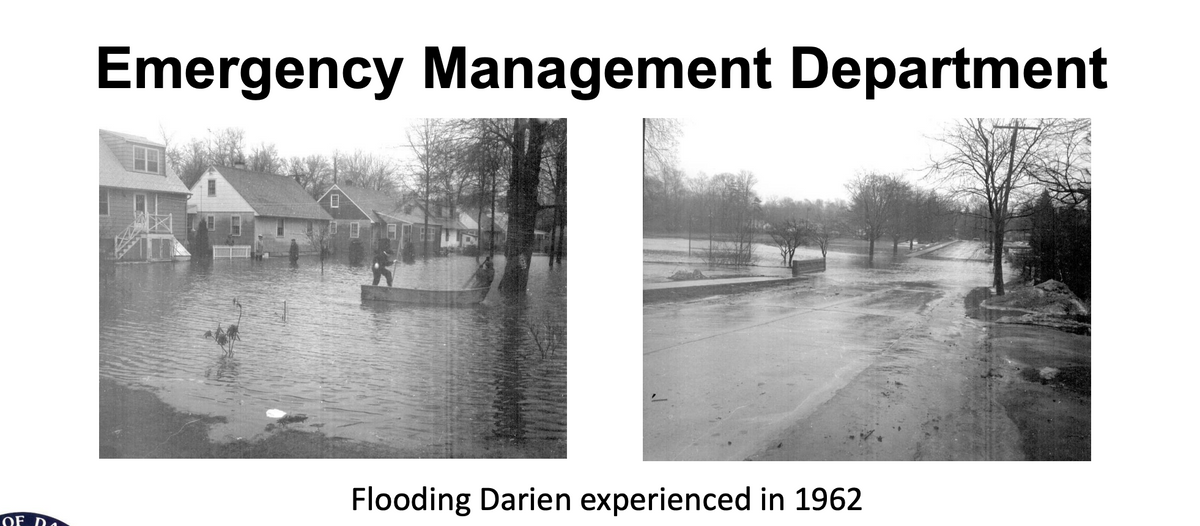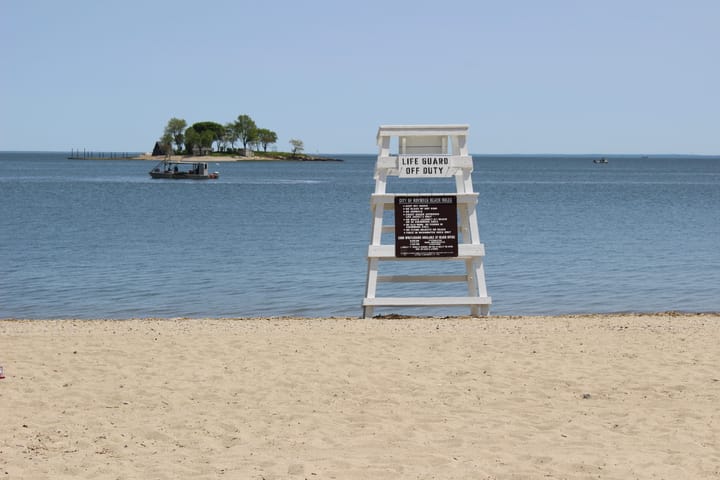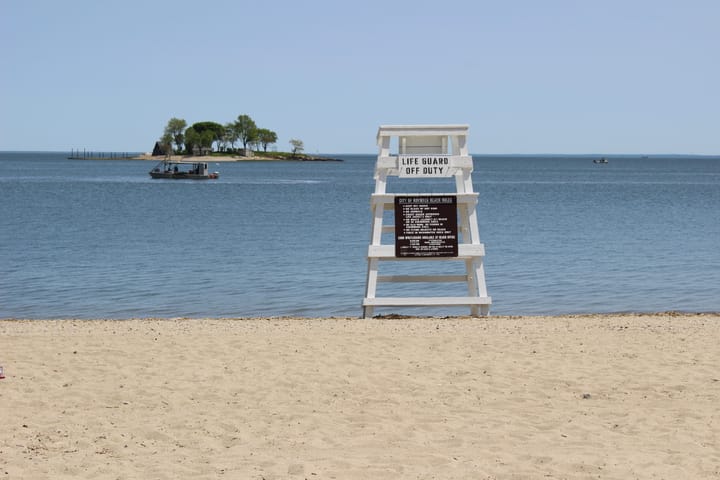Darien Officials Outline Lessons Learned, Efforts to Address Future Flooding
After Hurricanes Elsa and Ida impacted Darien, the town discussed lessons learned and efforts its taking to work on flooding-related issues.

Darien was one of the hardest hit communities in Connecticut when the remnants of Hurricane Elsa and Ida came through last year, officials said. That’s part of why the town decided to host an emergency preparedness and response public information session to share with members of the public what they learned from those storms and advice for residents for future storms.
Storms that feature a large amount of rain in a short amount of time are increasing, according to Craig Flaherty, a professional engineer for Redniss and Mead, who works with the town on flooding-related issues. Flaherty also serves on the town’s Sewer Commission so he said he knows some of the challenges Darien and its systems face.
He highlighted data from the National Climate Assessment, which showed that heavy rainfalls have increased by 55% between 1958 and 2016, and are projected to increase another 40% in the years to come. This could have a big impact on towns and cities infrastructure, particularly their stormwater management systems.
In 2021, Darien, and the whole region, experienced two severe weather events that caused large amounts of flooding, property damage, and infrastructure issues. The remnants of Hurricane Elsa dropped 6.66 inches during a 24-hour period across the town in July.
Just over a month later, Darien received 6.92 inches of rain from Ida in a 24-hour period. Despite their similar rain totals, the intensity of the Ida overwhelmed the town and many of its systems. The town received 3.31 inches in just an hour and 4.65 in two hours—both of which were considered “500-year events,” meaning they had a 0.2% chance of happening in a given year.
The amount of rain that fell during Ida was “off the charts,” according to Flaherty, who noted that in about 150 years of collecting data rainfalls this intense had not been documented.
While Flaherty said that “no systems are designed for a 500-year storm,” the town’s “typical systems are undersized,” so they can become overwhelmed even for storms that aren’t as severe.
Much of the town was developed before drainage and zoning regulations were put into place, Flaherty added, which means some homes were built in flood zones and wetlands and are at even higher risk of flooding as storms become more severe.
“It seems to be happening more and more,” he said.
Increased Regulations
In 2010, Darien adopted what Flaherty and others called “one of the strictest” set of stormwater management regulations to make sure that new developments—or redevelopments of properties—were built to withstand storms better and handle runoff to prevent the flooding of neighboring property. Flaherty said in 2018 that Darien proactively worked with FEMA to remap the town and accurately assess which properties should be mapped in a flood zone.
Jeremy Ginsberg, the town’s director of Planning and Zoning, said that all work done in flood zones requires a review and a vote from the full planning and zoning commission to ensure that the construction work complies with flood regulations. These regulations include not adding a basement to properties in a flood zone and having all living space and HVAC units at least a foot the flood level.
Flaherty and Ed Gentile, the director of public works, emphasized that property owners should use resources, such as FEMA’s flood maps, to see if their property is in a flood zone. If it is, they should make sure they have flood insurance.
The goal of these efforts is to “not eliminate but mitigate” flood-related challenges for residents, Ginsberg said.
Challenges with Flooding
Still, despite the town’s efforts, some mitigation efforts aren’t possible. Flaherty highlighted the Stony Brook River study, which looked at properties within the watershed, which is defined as a land area that channels rain or snow melt toward a body of water. The study explored multiple mitigation options, many of which cost millions of dollars for less than an inch or two reduction in flooding.
“We learned we couldn’t make a difference here,” Flaherty said. “We turned our focus to improving local drainage.”
He and Gentile said that the town has been working on “property-by-property resilience” to help owners shore up their own property and mitigate risks. This includes: removing items that could blow off the property and clog drains and culverts, such as outdoor furniture, and making sure generators and HVAC systems are protected.
Gentile also said that public works goes out before storms, especially to problem areas, to make sure drains and culverts are cleared out. He also learned his own lessons from Ida. Multiple public works vehicles were damaged by floodwaters that rose in a garage where they were parked. Now, when severe weather threatens, part of their protocol is to move the vehicles to higher ground.
Infrastructure Upgrades
Gentile said that they are awaiting to see the results of three other studies—the Salt Box–Coach Lamp area, the Bailey Avenue area, the Grove Street–Tilley Pond area—to see if improvements, such as widening channels or increasing the size of the drainage system could make a difference.
They’re also working to upgrade drainage systems around the town including along West Avenue, Fairfield Avenue, and Long Neck Point, he said. There is also repair work taking place at Gorham’s Pond Dam, which is estimated to cost about $1.5 million to fix.
Essential Documentation
If there is a storm that causes damage to a property, Marc McEwan, the town’s director of emergency management, encouraged residents to document what was destroyed and, if possible, how. This could include photos/videos of a property flooding, the damage found in the aftermath, etc. This not only helps with insurance claims, but also for the town to get a disaster declaration—which opens up federal assistance—if it’s warranted. Darien received one in the aftermath of Ida, due to the level of destruction that happened in the town.
Emergency Response and Safety
When storms do hit, Chief of Police Don Anderson said that his members are ready to respond. They work ahead of time to make sure their equipment is “fully operational and ready for deployment,” including readying generators, placing barricades in flood prone areas, and restocking emergency supplies.
He emphasized that residents can help in their efforts by delaying routine calls for service until after the storm has passed and by not taking unnecessary risks, such as trying to drive down a road that is barricaded.
“If it’s there, that road is blocked for a reason,” he said.
David Knauf, the town’s health director, encouraged residents to have an emergency supply kit ready if a large storm is forecasted to hit the area. This kit should include “food, water, utensils, change of clothes, blankets and pillows, toiletries, battery-powered radio and extra batteries, medication, medical supplies, eyeglasses and spare contacts,” as well as a health information card that includes medications and conditions.
He also recommended residents keep gloves and boots on hand to clean out flooded areas since floodwaters can contain a lot of bacteria and cause mold.
Knauf reminded residents not to run generators indoors or run their cars because those can cause carbon monoxide poisoning.
Residents are encouraged to visit the town’s Emergency Management page to find out more information and resources.



